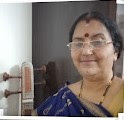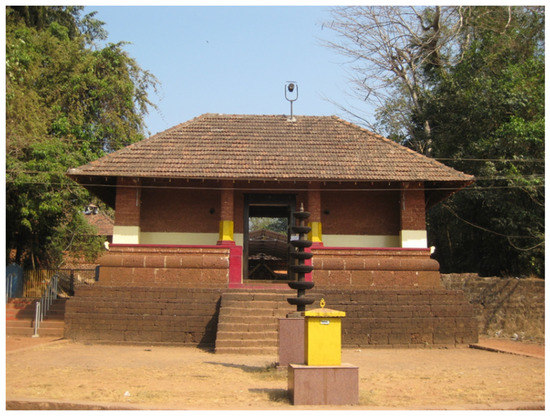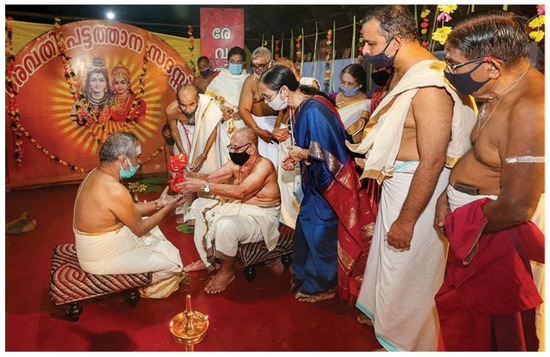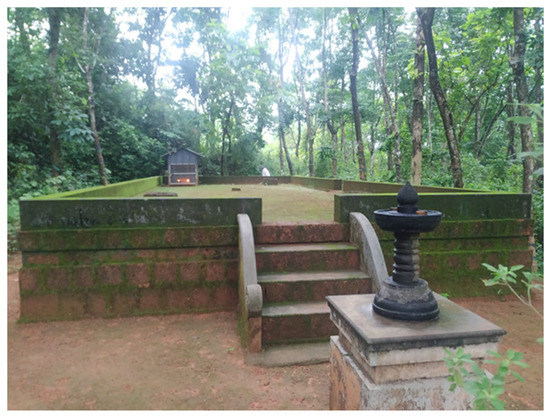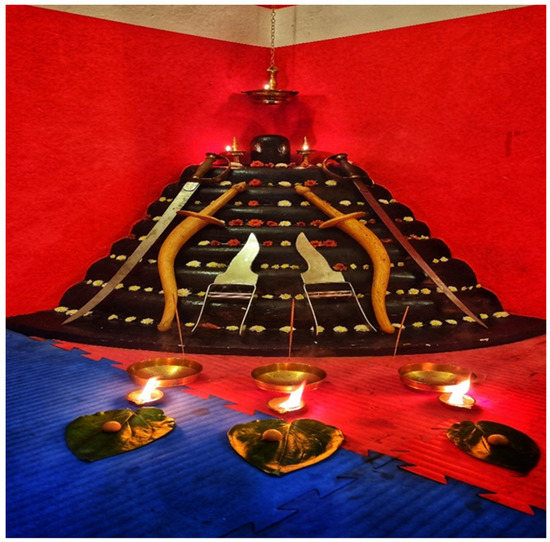18 aṣṭādaśadaśakaḥ - rāmakathā
sūryānvaye dāśarathī rameśo rāmābhidho'bhūdbharato'tha jātaḥ .
jyeṣṭānuvarttī khalu lakṣmaṇaśca śatrughnanāmā'pi jagadvidhātri .. 18-1..
vimātṛvākyojjhitarājyabhogo rāmaḥ sasītaḥ sahalakṣmaṇaśca .
caran jaṭāvalkalavānaraṇye godāvarītīramavāpa devi .. 18-2..
taṃ vañcayan rāvaṇa etya māyī jahāra sītāṃ yatirūpadhārī .
rāmasya patnīvirahāturasya śrutvā vilāpaṃ vanamapyarodīt .. 18-3..
śrīnārado'bhyetya jagāda rāmaṃ kiṃ rodiṣi prākṛtamartyatulyaḥ .
tvaṃ rāvaṇaṃ hantumihāvatīrṇo hariḥ kathaṃ vismarasīdamārya .. 18-4..
kṛte yuge vedavatīti kanyā hariṃ śrutijñā patimāptumaicchat .
sā puṣkaradvīpagatā tadarthamekākinī tīvratapaścakāra .. 18-5..
śrutā tayā'bhūdaśarīrivāk te hariḥ patirbhāvini janmani syāt .
niśamya taddhṛṣṭamanāstathaiva kṛtvā tapastatra nināya kālam .. 18-6..
tāṃ rāvaṇaḥ kāmaśarārdditaḥ saṃścakarṣa sā ca stavanena devīm .
prasādya kopāruṇalocanābhyāṃ nirīkṣya taṃ niścalamātatāna .. 18-7..
śaśāpa taṃ ca tvamare madarthe sabāndhavo rākṣasa naṃkṣyasīti .
svaṃ kauṇapaspṛṣṭamaśuddhadehaṃ yogena sadyo vijahau satī sā .. 18-8..
jātā punaḥ sā mithileśakanyā kāle hariṃ tvāṃ patimāpa daivāt .
sa hanyatāṃ satvaramāśarendrastannāśakālastu samāgataśca .. 18-9..
tadarthamārādhaya lokanāthāṃ navāhayajñena kṛtopavāsaḥ .
prasādya tāmeva surā narāśca kāmān labhante śubhameva te syāt .. 18-10..
ityūcivāṃsaṃ munimeva rāma ācāryamākalpya salakṣmaṇastvām .
sampūjya susmeramukhīṃ vratānte siṃhādhirūḍhāṃ ca puro dadarśa .. 18-11..
bhaktyā nataṃ taṃ drutamāttha rāma haristvamaṃśena madājñayaiva .
jāto naratvena daśāsyahatyai dadāmi tacchaktimahaṃ taveha .. 18-12..
śrutvā tavoktiṃ sa hanūmadādyaiḥ sākaṃ kapīndraiḥ kṛtasetubandhaḥ .
laṅkāṃ praviṣṭo hatarāvaṇādyaḥ purīmayodhyāmagamatsasītaḥ .. 18-13..
hā devi bhaktirna hi me guruśca na caiva vastugrahaṇe paṭutvam . satsaṅgatiścāpi na te patantu kṛpākaṭākṣā mayi te namo'stu .. 18-14..
१८ अष्टादशदशकः - रामकथा
18 asht'aadashadashakah' - raamakathaa
(When the devas were troubled by Ravana Lord Vishnu took
incarnation as Lord Rama. On the day when he was to be made the
king, he went to the forest along with his wife and Brother. There
Ravana abducted his wife. Sage Narada reminded Rama that he is
Lord Vishnu and his wife was Vedavathi. He advises him to worship
the goddess for nine nights. The Goddess appeared before him. Her
Sakthi and Rama killed Ravana with the help of Hanuman and other
monkeys. And later he became king of Ayodhya. These are told in
chapters 28,29,&30 of the book 3 of Devi Bhagwatham.)
सूर्या न्वर्े दयशरथी रमेशो
रयमयभिधोऽिूद्भरतोऽथ जयतः ।
ज्येष्टयनुवर्त्ती खलु लक्ष्मणश्च
शत्रुघ्ननयमयऽभि जगभिधयभत्र ॥ १८-१॥
Sooryaanvaye daasharathee ramesho
raamaabhidho'bhoodbharato'tha jaatah' .
jyesht'aanuvarttee khalu lakshmanashcha
shatrughnanaamaa'pi jagadvidhaatri .. 18-1..
1.Oh! mother of this universe, Vishnu took birth in the
suryavamsham clan, as the son of Dasaratha and was named as
Rama. Bharatha also was born. Subsequently Lakshmana and
Shathrugna were also born.
The adjective ‘daasharathee’-son of dasaratha-can be used for all the
4 sons. Dasaratha and kaushalya’s son was Rama; kaikeyi’s son was
bharata; and sumitra’s sons were Lakshmana and shathrughana
भवमयतृवयक्योज्झितरयज्यिोगो
रयमः ससीतः सहलक्ष्मणश्च ।
चरन् जटयवल्कलवयनरण्ये
गोदयवरीतीरमवयि दे भव ॥ १८-२॥
vimaatri'vaakyojjhitaraajyabhogo
raamah' saseetah' sahalakshmanashcha .
charan jat'aavalkalavaanaranye
godaavareeteeramavaapa devi .. 18-2..
2.Oh Goddess, as per the instructions of his step mother, Rama gave
up the joy of kingship and along with Lakshmana and Sita, with
matted hair and clothes made of barks of wood, walked through
forests and finally reached the banks of Godavari river.
The sons of Dasharatha grew. It was time to conduct the raja
abhishekam on the young princes. Though Rama was the elder son,
kaikeyi was stubborn that her son bharat should be crowned the
king, also that rama should go to the forest. With a very reluctant
mind dasharath was forced to agree. Rama along with his wife sita
went to the forest. Lakshmana followed. All 3 of them reached the
banks of the Godavari river. There they met a love struck
shoorpanakha-ravana’s sister-and deformed her. What happened
after that is explained below:
तं वञ्चर्न् रयवण एत्य मयर्ी
जहयर सीतयं र्भतरूिधयरी ।
रयमस्य ित्नीभवरहयतुरस्य
श्रुत्वय भवलयिं वनमप्यरोदीत् ॥ १८-३॥
tam vanchayan raavana etya maayee
jahaara seetaam yatiroopadhaaree .
raamasya patneevirahaaturasya
shrutvaa vilaapam vanamapyarodeet .. 18-3..
3.The magical Ravana, wearing the garb of a sage, came and
deceived Rama and abducted Sita. Hearing the wail of Rama due to
parting with his wife, even the forest wailed.
In order to take revenge on Rama, according to the instructions
given by Ravana, Mareechi came in the guise of a golden deer and
tempted sita. To fulfil Sita’s desire Rama followed the deer. On
hearing the sound of someone in great pain, Lakshmana also went
there. Like this both Rama and Lakshmana were not there in the hut,
and taking this opportunity, Ravana dressed up like a sanyasi went to
see sita and kidnapped her. When Rama and Lakshmana reached the
hut Sita was not there. Rama cried out loud. On hearing Rama cry,
even the forest felt sad.
श्रीनयरदोऽभ्येत्य जगयद रयमं
भकं रोभदभि प्रयकृतमत्यातुल्यः ?
त्वं रयवणं हन्तुभमहयवतीणो
हररः कथं भवस्मरसीदमयर्ा ॥ १८-४॥
shreenaarado'bhyetya jagaada raamam
kim rodishi praakri'tamartyatulyah' ?
tvam raavanam hantumihaavateerno
harih' katham vismaraseedamaarya .. 18-4..
4.Sage Narada came there and told Rama, “Why are you sorrowing
like an ordinary man? You are Lord Vishnu, who has been born here
for the sake of killing Ravana, Oh Lord Vishnu, How did you forget
this fact?”
Sage narada appeared in front of a crying Rama. He reminded rama-
“you are not an ordinary man. Actually you are Vishnu who has been
born to kill ravana. Have you forgotten this”.
कृते र्ुगे वेदवतीभत कन्यय
हररं श्रुभतज्ञय िभतमयप्तुमैच्छत् ।
सय िुष्करिीिगतय तदथाम्
एकयभकनी तीव्रतिश्चकयर ॥ १८-५॥
kri'te yuge vedavateeti kanyaa
harim shrutijnyaa patimaaptumaichchhat .
saa pushkaradveepagataa tadartham
ekaakinee teevratapashchakaara .. 18-5..
5. In the Kreta yuga a young girl called Vedavathi, who was a scholar
of Vedas, went alone to an island called Pushkara and did penance,
to get Lord Vishnu as her husband.
Narada muni continues,”long ago, in kreta yuga a girl was born to a
king named kushdhwaja. When she was young itself she knew the
vedas. So, her father and mother named her Vedavati. Vedavati
desired to make Vishnu her husband. For this she went to the island
named pushkara and stayed alone and observed severe penance.”
श्रुतय तर्यऽिूदशरीररवयक्-“ ते
हररः िभतिया भवभन जन्मभन स्ययत् ”
भनशम्य तद् धृष्टमनयस्तथैव
कृत्वय तिस्तत्र भननयर् कयलम् ॥ १८-६॥
shrutaa tayaa'bhoodashareerivaak-‘te
harih' patirbhaavini janmani syaat .’
nishamya taddhri'sht'amanaastathaiva
kri'tvaa tapastatra ninaaya kaalam .. 18-6..
6. “She heard a voice from heaven telling her, You will get Lord
Vishnu as your husband in your next birth. Hearing this with great
joy, she continued doing penance and continued to live there only.”
Sri narada continues, vedavati’s penance materialised. In her next
birth she will get Vishnu as her husband was told to her by a divine
voice. Doing penance, she continued to stay there.”
तयं रयवणः कयमशरयभदा तः सं -
श्चकिा सय च स्तवनेन दे वीम् ।
प्रसयद्य कोियरुणलोचनयभ्ययं
भनरीक्ष्य तं भनश्चलमयततयन ॥ १८-७॥
taam raavanah' kaamasharaardditah' sam-
shchakarsha saa cha stavanena deveem .
prasaadya kopaarunalochanaabhyaam
nireekshya tam nishchalamaatataana .. 18-7..
7.Ravana in a passionate moment tried to pull her towards him. She
pleased the goddess with her prayers and with eyes red due to great
anger, She stared at him and made him motionless.
Sri narada continues,” while vedavati was observing penance-at
pushkara island-and staying there, one day, ravana came there. On
seeing the beauty of the young girl he became lustful, and tried to
catch her by force. She prayed to devi and pleased her. With eyes
red with anger she stared at ravana. With that he became immobile,
like a statue.”
शशयि तं च त्वमरे मदथे
सबयन्धवो रयक्षस नं क्ष्यसीभत ।
स्वं कौणिस्पृष्टमशुद्धदे हं
र्ोगेन सद्यो भवजहौ सती सय ॥ १८-८॥
shashaapa tam cha tvamare madarthe
sabaandhavo raakshasa nankshyaseeti .
svam kaunapaspri'sht'amashuddhadeham
yogena sadyo vijahau satee saa .. 18-8..
8.She also cursed him. “Hey Rakshasa, you along with all your
relatives will be destroyed because of me.” And immediately with the
power of yoga, gave up her body, that which had got impure due to
the touch of the rakshasa
Sri narada continues,” vedavati cursed the immobile ravana. ‘Because
of me, may you be destroyed along with all your relatives’-these
were the words of her curse. She was going to be the wife of Vishnu,
that body had become impure by the touch of a lust filled man, who
was a stranger. That body she gave up.”
जयतय िुनः सय भमभथलेशकन्यय
कयले हररं त्वयं िभतमयि दै वयत्
स हन्यतयं सत्वरमयशरे न्द्र-
स्तन्नयशकयलस्तु समयगतश्च ॥ १८-९॥
jaataa punah' saa mithileshakanyaa
kaale harim tvaam patimaapa daivaat .
sa hanyataam satvaramaasharendra-
stannaashakaalastu samaagatashcha .. 18-9..
9. ”It Was she, who was born later as daughter of the king of
Mithila(Sita). By the grace of devi, she later chose you as husband, as
you are Lord Vishnu. Please swiftly destroy that king of Rakshasas,
for the time of his destruction has come.”
Sri narada continues,” in your next birth lord Vishnu will be your
husband”, the divine voice that told vedavati was already mentioned
earlier. That vedavati was reborn as Sita. What the divine voice said
that day materialised today-rama, an incarnation of Vishnu, she got
as her husband. Let the curse that she gave ravana that day also
materialise without any delay. The time has come to destroy ravana
and several other rakshasas. The time to destroy Ravana has come”.
The story of vedavati is given in explained in srimad devi
bhagvatham 9th skanda chap 16
तदथामयरयधर् लोकनयथयं
नवयहर्ज्ञेन कृतोिवयसः ।
प्रसयद्य तयमेव सुरय नरयश्च
कयमयन् लिन्ते शु िमेव ते स्ययत् ॥ १८-१०॥
tadarthamaaraadhaya lokanaathaam
navaahayajnyena kri'topavaasah' .
prasaadya taameva suraa naraashcha
kaamaan labhante shubhameva te syaat .. 18-10..
10. For this, worship the Goddess, by observing a fast and
conducting a Navaha Yajna. All devas and humans pray only to that
goddess, and get their desires fulfilled and it will only do you good.
Sri narada continues,” the time to kill ravana has come. For that rama
has to fast and conduct a navaha yagna. Hear devi’s story, chant devi
shlokas, sing bhajans on devi, pray to devi- like this remember and
praise devi for 9 days. Devi will be pleased by this. Like this you will
be able to kill ravana. Devas & humans-all-have their desires fulfilled
by pleasing devi. Rama, you too will benefit from this.” After saying
all this the rishi disappeared.
इत्यूभचवयं सं मुभनमे व रयम
आचयर्ामयकल्प्प्य सलक्ष्मणस्त्वयम् ।
सम्पूज्य सुस्मेरमु खीं व्रतयन्ते
भसंहयभधरूढयं च िु रो ददशा ॥ १८-११॥
ityoochivaamsam munimeva raama
aachaaryamaakalpya salakshmanastvaam .
sampoojya susmeramukheem vrataante
simhaadhirood'haam cha puro dadarsha .. 18-11..
11.Thus finishing his talk like this, narada, who was considered by
rama as his guru, along with Lakshmana, worshipped you, and at the
end of the penance had a vision of you sitting on the lion with a
sweet smile.
Because the maharshi advised him when he needed it the most, he
considered him(narada) as his guru and as adviced by the acharya,
rama started the navaha yagna. As he completed the yagya on the
9th day he saw devi sitting on a lion smiling sweetly, very clearly.
िक्त्यय नतं तं द्रुतमयत्थ रयम
हररस्त्वमंशेन मदयज्ञर्ैव ।
जयतो नरत्वेन दशयस्यहत्यै
ददयभम तच्छज्झिमहं तवेह ॥ १८-१२॥
bhaktyaa natam tam drutamaattha raama
haristvamamshena madaajnyayaiva .
jaato naratvena dashaasyahatyai
dadaami tachchhaktimaham taveha .. 18-12..
12.When he at once saluted you, you reminded him, “Oh Rama you
are Lord Vishnu. And as per my wishes, You were born as a human
to kill the 10 headed Ravana. And I am now giving you the power to
kill ravana.
On seeing devi, rama immediately prostrated with devotion. Devi
reminded rama, who had forgotten, who he was. Rama is none other
than Vishnu. By parting a portion of him, he was born as a human to
dasharath as his son. The killing of ravana was his aim. It is by the
order of devi that he was born as a human-all these incidents that
had taken place he had forgotten. Now the devi reminded him of all
that. She also gave him the powers needed to kill ravana. ‘ may you
be destroyed because of me’, the curse by Vedavathi is going to
materialise now. It is vedavathi who had been reborn as sita in treta
yuga. The kidnapping of sita became a reason for the killing of
ravana.
श्रुत्वय तवोज्झिं स हनूमदयद्यैः
सयकं किीन्द्रैः कृतसेतुबन्धः ।
लङ्यं प्रभवष्टो हतरयवणयद्यः
िुरीमर्ोध्ययमगमत्ससीतः ॥ १८-१३॥
shrutvaa tavoktim sa hanoomadaadyaih'
saakam kapeendraih' kri'tasetubandhah' .
lankaam pravisht'o hataraavanaadyah'
pureemayodhyaamagamatsaseetah' .. 18-13..
13. After hearing you, he built a bridge on the sea with the help of
Hanuman and other monkeys, entered Lanka, killed Ravana and
others, And along with Sita entered the city of Ayodhya.
With the blessings of the devi, Rama without any delay made contact
with hanuman and other monkeys associated with him. At great
speed the search for sita progressed. It was understood that sita was
in lanka. A bridge was constructed across the ocean. They crossed
over to lanka. Ravana and his associates were slayed. Sita was
welcomed back. Rama along with sita and Lakshmana returned to
ayodhya. If we get the blessings of devi the way to fulfil our wishes
will be shown. A very good example of this is the story of rama. In
Devi bhagvatham in the 3 chapters of 3rd skandam, chapters 28,
29, 30 the story of rama has been explained.
हय दे भव िज्झिना भह मे गुरुश्च
न चैव वस्तुग्रहणे िटु त्वम् ।
सत्सङ्गभतश्चयभि न ते ितन्तु
कृियकटयक्षय मभर् ते नमोऽस्तु ॥ १८-१४॥
haa devi bhaktirna hi me gurushcha
na chaiva vastugrahane pat'utvam .
satsangatishchaapi na te patantu
kri'paakat'aakshaa mayi te namo'stu .. 18-14..
14.Hey Goddess, alas I do not have devotion, I do not have a guru
also. I don’t need to understand a concept nor do I have the
expertise to understand anything nor do I have the chance, or even
the capacity to keep good company. Let your merciful look fall on
me My salutations to you.
Rama considered narada to be his guru. On listening to the muni’s
words, devotion to devi arose. His wishes were fulfilled also. The
poet says he does not have a guru, nor the benefits of keeping good
company nor the capabaility to understand materialism he prays to
her to bless him
Thus ends the 18th chapter
Other stories
There lived, in olden times, in the city of Ayodhyā, a prosperous king of the
solar dynasty named Daśaratha. He always worshipped the Devas and
Brāhmaṇas.
He had four celebrated sons Rāma, Lakṣmaṇa, Bharata and Shatrughna. These
four sons were equally learned and beautiful and they always did actions
agreeable to the king. Of these, Rāmachandra was the son of the Queen
Kauśalya, Bharata was the son of Kaikeyī, and the good looking Lakṣmaṇa and
Shatrughna were the twin sons of Sumitrā. While young, they learned the art
of archery and began to play with bows and arrows in their hands.
Thus educated and purified, the four sons began to give delight more and
more to the king; one day the Maharṣi Viśvāmitra came to Ayodhyā and aked
from the king Daśaratha the help of his son Rāmacandra for the protection of
his sacrificial ceremonies. The king could not cancel the Viśvāmitra’s request
and sent with him Rāma, accompanied by Lakṣmaṇa.
The lovely Rāma and Lakṣmaṇa accompanied the Muni on his way back. There
lived a terrible looking Rākhṣasī, named Tāḍakā, in a forest on their way, who
used to give great troubles to the ascetics; and Rāma killed her with only one
arrow. Next he killed Subāhu and shot arrows at another night-wanderer
Mārīca and made him senseless, almost dead and threw him at a great
distance and thus saved Viśvāmitra from all the obstacles troubling him in his
sacrificial ceremonies. Thus fulfilling the great work, protecting the sacrificial
ceremonies, Rāma, Lakṣmaṇa and the Muni kaushik, the three, started for the
kingdom of Mithilā. On his way, Rāmachandra rescued Ahalyā from the curse
that she was suffering from.
At last the two brothers, accompanied by the Muni, reached the city
Videhanagar. Just at this time the king Janaka of Ayodhyā made a vow to give
in marriage, his daughter, Sītā to anybody who will be able to break the bow of
Śiva; Rāma broke that bow into two and married Sītā, who was born of Lakṣmī’s
parts. Then king Janaka gave in, marriage, to Lakṣmaṇa his own-daughter
Urmilā.
The good and auspicious Bharata and Satrughna married respectively Māndavi
and Śrutakīrti, the two daughters of Kuśadhvaja.
O king! Thus, in the great city of Mithilā, the four brothers performed their
marriage ceremonies, according to the prescribed rules and rites.
Ravana’s abduction of Sita
Rāvaṇa said :-- “O suspiciously looking one! I am the king of Laṅkā, the
husband of Mandodarī. O beautiful one! it is for you that I have put on this
dress of Yati.
O beautiful! My two brothers Khara and Dūṣaṇa have been killed in this forest;
and being urged by my sister I have come here.
Now leave this man-husband, residing in the forest as a pauper, devoid of
fortune and wealth; and worship me as a husband. O fair one! I am Rāvaṇa, the
king of kings; you now become my lord.
O daughter of Janaka! I am the lord of the Regents of the quarters; and yet I
bow my head down to your lotus feet; better accept me and fulfil my desires
today.
Formerly I asked of you from your father, the king Janaka; but he then said,
that he had laid a pledge, ‘Whoever will break the Śiva’s bow will marry my
daughter.’ The Bhagvān Rudra is my Guru; hence I feared to break his bow,
and therefore I was not present in your Svayamvara. But from that time my
mind is always thinking of you and is in a state of bereavement for you.
O beautiful one! Hearing now that you are residing in this forest, I, impelled by
my previous fascination for you, have now come hither; and you better now
crown my labour with success.”
The story of vedavati is given and explained in srimad devi
bhagvatham 9th skanda chap 16
There were 2 rishis named dharmadwaja and Kusha Dwaja who did great
Penance and Meditation for Goddess Lakshmi Devi. They were rich and wealthy
in every aspect because of the blessings of goddess.
Kushadwaja’s wife gave birth to a baby girl, when the baby was born, chants of
vedas were heard all around hence they named her as ”Vedhavathi” they did not
realize that she is incarnation of goddess Lakshmi Devi Herself. After Vedavathi
grew up into young lady, she wished to have Lord Shri Pathi (Vishnu) as her
husband and started doing penance. Then one day there was a voice from
unknown source, saying,’Lord Shri Pathi (i.e Vishnu) would be your husband in
your next life , now you can stop your penance.” But she did not stop doing the
Penance She moved to Mount GangaMaadhana started doing more serious
penance. one day the irresistible Rāvana came there as guest.
No sooner Vedavatî saw the guest, then she gave him, out of devotion to the
guest, water to wash feet, delicious fruits, and cool water for his drink. The villain
accept the hospitality and sitting there, began to ask :-- “O Auspicious One! Who
are you?” Seeing the fair smiling lady, with beautiful teeth, her face blooming
like the autumnal lotus, of heavy loins, and of full breast, that villain became
passionate. He lost entirely all consciousness and became ready to make sexual
advancement towards Her. Seeing this, the chaste Vedavatî, became angry and
out of her tapas influence, stunned him and made him numb to move. He
remained motionless like an inanimate body. He could not move his hands nor
feet nor could he speak. That wicked fellow then mentally recited praises to her.
And the praise of the Higher S’akti can never go futile. She became pleased and
granted him religious merits in the next world. But she also pronounced this
curse :-- “That when you touch my body out of passion, then you will be ruined
with your whole family for my sake. Now see my power.” Thus saying to Râvana,
Vedavatî left her body by her yogic power. Then Râvana took her body and
delivered it to the Ganges and he then returned to his own home. But Râvana
thought over the matter repeatedly and exclaimed, “What wonder have I seen!
Oh! What a miracle this lady has wrought!” Râvana thus howled. This Vedavatî,
of pure character, took her birth afterwards as Sîtâ, the daughter of Janaka.
For the sake of this Sîtâ, Râvana was ruined with his whole family. By the religious
merits of her previous birth, the ascetic lady got Bhagavân Hari S’rî
RâmaChandra, the Fullest of the Full, for her husband and remained for a long
time in great enjoyment with the Lord of the world; a thing very difficult to be
attained! Though she was a Jâtismarâ (one who knows all about her past lives),
she did not feel any pain due to her practising severe austerities in her previous
birth; for when the pains end in success, the pains are not then felt at all. Sîtâ, in
Her fresh youth enjoyed various pleasures in the company of her
husband,handsome, peaceful, humorous and witty, the chief of the Devas, loved
by the female sex, well-qualified, and just what she desired. But the all-powerful
Time is irresistible; the truthful Râmachandra, the scion of the Raghu’ family, had
to keep up the promise made by his father and so he had to go to the forest,
ordained by Time. He remained with Sîtâ and Laksmana near the sea.
Once the fire God appeared to Him in the form of a Brâhmana. Fire, in a
Brâhmin-form, saw Râma Chandra morose and became himself mortified. Then
the Truthful Fire addressed the truthful Râmachandra :-- “O Bhagavân
Râmachandra! I now speak to you how time is now coming to you. Now has
come the time when your Sîtâ will be kidnapped. The course of Destiny is
irresistible; none else is more powerful than Time, Fate. So give over your Sîtâ,
the World Mother to me and keep with you this Chhâyâ Sîtâ (the shadow of Sîtâ;
the false Sîtâ). When the time of Sîtâ’s ordeal by fire will take place I will give
Her back to you. The Devas united have sent me to you. I am not really a
Brâhmin; but I am Agni Deva (eater of oblations).” Râmachandra heard Fire and
gave his assent. But his heart shattered. He did not speak of this to Laksmana.
By the yogic power Agni (Fire) created a Mâyâ Sîtâ. This Mâyâ Sîtâ, O Nârada,
was perfectly equal to the real Sîtâ. Fire, then, handed this Mâyâ Sîtâ to the hands
of Râmachandra.
Hûtâsana (fire) took the real Sîtâ and said, “Never divulge this to any other body”
and went away. What to speak of divulging the secret to any other body,
Laksmana even could not know it. By this time Râma saw one deer, made of all
gold. To bring that deer carefully to her, Sîtâ sent Râmachandra with great
eagerness. Putting Sîtâ under Laksmana’s care, in that forest, Râma went himself
immediately and pierced the deer by one arrow. That Mâyâ mrîga (the deer
created by magic powers) on being pierced, cried out “Ha Laksmana!” and
seeing Hari before him and remembering the name of Hari, quitted his life. The
deer body then vanished; and a divine body made its appearance in its stead.
This new body mounting on an aerial car made of jewels, ascended to Vaikuntha.
That Mâyik (magic) deer was in its previous birth, a servant, of the two gate-
keepers of Vaikuntha; but, for the sake of some emergency, he had to take up
this Râkhsasa birth. He again became the servant of two door-keepers of
Vaikuntha. On the other hand Sîtâ Devî, hearing the cry “Ha Laksmana!” became
very distressed and sent Laksmana in search of Râma. No sooner did Laksmana
get out of the hermitage, the irresistible Râvana took away Sîtâ gladly to the city
of Lanka (Ceylon). Now Râmachandra, seeing Laksmana on the way in the forest,
became merged in the ocean of sorrows and without losing any time came
hurriedly to the hermitage where he could not find Sîtâ. Instantly he fell
unconscious, on the ground; and, after a long time, when he regained his
consciousness, he grieved and wandered here and there in search of Her. After
some days on the banks of the river Godâvarî, getting the information of Sîtâ,
he built a bridge across the ocean with the help of His monkey armies. Then he
entered with his army into Lanka and slew Râvana with arrows with all his friends.
Note: The story about the origin of Slta Devi runs thus: Ravana, the king of
Ceylon (Lanka) practised very severe austerities and got extraordinary powers.
He brought the three worlds under his subjection, levied taxes from all. The
Devas and all the other inhabitants of the several worlds paid their taxes, as
imposed by Ravana. Ravana sent messengers to the Rsis and the Munis, the
ascetics, dwelling in forests and asked then to pay their taxes. The Rsis replied
that they had no property. But Ravana insisted. The Rsis gave, them, blood,
cutting their thighs, in ajar that was carried to Lanka. Ravana kept that jar under
the custody of his queen Mandodarl and instructed her that the jar contained
poison and that she should not eat that. Mandodari, however, ate a portion of
that, out of curiousity, and became pregnant and gave birth to a daughter.
Fearing Ravana, she floated the jar with the daughter, in the ocean, which,
floating through oceans and rivers, came and touched the lands of the King
Janaka. The peasants while tilling, found that and took the girl to the king, who
reared her as his daughter. Thus Sita, born out of the blood of the Brahmanas,
took away subsequently the kingdom, life, and all of Ravana.
Another version is this: As before, the messenger advised the Munis to give
something; otherwise Ravana would insist and put them to various troubles. So
the Munis cut their thighs and gave blood as their tax, saying that that blood in
the jar would cause ruin and desolation to the country where it will be kept.
Ravana, hearing this, ordered the jar to be carried to the kingdom of the king
Janaka, thus causing ruin to him. The jar was brought and placed in the fields of
Janaka.
Now it happened that there was a very severe drought; rains were absolutely
wanting; and a dire famine was imminent. The Brahmin Pundits informed the
king that if the king and his wife ploughed themselves the fields, rains would
fall. So the king with his wife did that, the king holding the plough and the
queen holding the hand of the king. The fore-end of the plough accidentally
hit upon that jar, out of which came out Slta Devi with two women Rddhi and
Siddhi, waving chowries on her two sides. The two ladies disappeared and Sita
Devi looked like a girl. The king Janaka reared her, as if his daughter. Sita Devi
use to lift daily with her left hand the bow of Siva, kept in the king’s house, and
daily worshipped that, and thus cleansed the place: Seeing this, the king
Janaka pledged the vow that, whoever would break the Siva’s bow, would
marry Sita.
